Introducing strategies that will help CIOs take advantage of ITaaS to transform their IT organization into the strategic partner business lines need. In recent years business lines have been increasingly going the shadow IT route to achieve their critical objectives, showing there’s a real disconnect with IT as to how to leverage cloud computing.
The problem lies with cloud vendors who ignore the issue of the business vision. They see low IT costs and accelerated application delivery as business growth-drivers while businesses are more concerned with market responsiveness achieved through agile and collaborative environments that bring together the business and IT.
The business is right: organizational silos, hierarchical barriers, unclear business priorities and people issues like power struggles, resistance to change, defiance of policies and politics are all impediments that only make it more difficult to achieve flexibility, fast problem solving and decision making.
The solution is to implement IT-as-a-Service (ITaaS) in the form of integrated platforms of people, processes, practices, governance structure and tools specifically built to bring the business and IT together.
The business facet of the digital revolution is what matters
The digital revolution which get so much buzz is incompletely explained to CIOs. What they must understand is, to succeed, businesses need to implement integrated digital strategies.
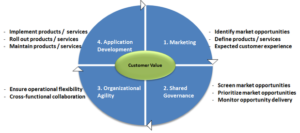
As Figure 1 shows, what matters most is to increase customer value, not the extensive automation of application deployment suggested by techies. In fact the business belief is customer value (what customers spend to buy services) results from the organizational dynamics where through a shared governance, IT addresses the opportunities prioritized by marketing, and leverages organizational agility and accelerated application deployment mechanisms to continuously deliver added-value services.
The importance of ITaaS delivery models
The above perspective is accepted in the industry. VMware and EMC even designate ITaaS as the model through which to implement it. Yet, an overall framework clarifying its principles, organizational and operational implications as well as its deployment practices is still missing.
Most consultants and vendors remain stuck in a techie mindset in which business concerns are at the periphery, not the core. The solution rests on the principles of frameworks like the Complete ITaaS Delivery Model™ which seeks to increase customer value through three fundamental drivers: the Cloud Platform, the Cloud Services and the IT Operating Model, as shown in Figure 2.
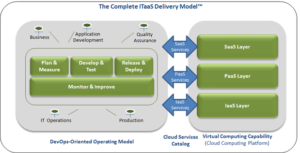
The logic is, increasing customer value isn’t as simplistic as delivering applications at the speed of light through automated IT processes; rather, it’s part of a virtuous circle that spans effective marketing, accelerated application deployment and, most importantly, organizational efficiency improvement. In his best-seller Reengineering the Corporation, former MIT computer science professor Michael M. Hammer warned, “automating a mess yields an automated mess.”
What’s needed is authentic cloud services from vendors that guarantee, via clear SLAs, available, reliable and scalable IT resources, consumable in a self-service and on-demand manner. They release operational latitudes that create the conditions for organizational agility.
Similarly, the organization’s operating model’s elements – including people, processes, practices, tools and governance structure – must be arranged in a way that creates operational agility. Without it, market responsiveness is a wishful thinking.
Key steps CIOs must take to align their IT to ITaaS
One of the reasons digital transformation remains an “elusive mystique” as Joe McKendrick calls it in his must-read “The Elusive Mystique of The Digital Enterprise,” is IT players including the major IT vendors are stuck in short-term goals. They lack the big picture vision and don’t understand how cloud solutions, operating models and cloud services combine to generate customer value.
Following are three key steps you can take to align your IT to ITaaS.
1. Reinvent your CIO role, think beyond technology. The disconnect with the business has reached a tipping point, as the use of shadow IT demonstrates. By legitimizing the idea that technology is the only business growth driver, IT vendors have confined CIOs to the limited role of IT tools provider.
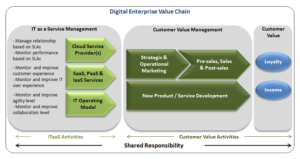
To win legitimacy the CIO must trade his tools provider jacket for that of business strategy facilitator. As Figure 3 shows, he must contribute to his organization’s Digital Enterprise Value Chain (a set of added-value activities) by focusing on IT as a Service Management activities.
2. Develop the vision of your future Virtual Computing Capability (VCC) and unlock the cloud’s cost savings. Taking your IT organization to ITaaS involves converting your datacenter into the VCC that’ll cut your IT costs and streamline your IT processes, as Figure 4 demonstrates.
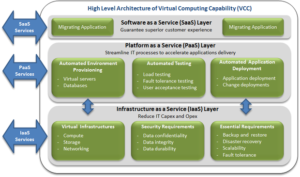
Discuss with your IT teams the following issues:
The workload to migrate including applications, software and hardware configurations as well as security, backup, disaster recovery and fault tolerance requirements
The overall architecture of your VCC, particularly the IaaS layer that’ll serve as the cost-effective Virtual Infrastructure and the PaaS layer that’ll implement a continuous delivery platform to enable accelerated application delivery
Operational management and executive control of the overall VCC
3. Rethink collaboration with the business, institutionalize DevOps to remove the impediments to operational flexibility and make your IT agile. For years essential value drivers like organizational and operational consistency, shared governance, executive consensus and cross-functional collaboration have been ignored. Whether techies admit it or not, poor IT focus on priorities, organizational dysfunctions, poor policy adoption and the like are the primary impediments to value and they aren’t fixed by technology.
When not narrowed to improving communication between application development and IT operations and to automating application deployment processes, DevOps is the agile and collaborative platform to adopt. Extended to business issues, its principles, processes and practices simplify the organization’s collaboration network and accelerate prioritization and decision-making, helping to make the operating model agile.
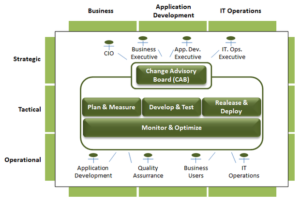
Set up an ITaaS task force involving the business and IT to discuss the following issues:
Establishment of an extended DevOps structure that’s not only focused on application development but spans the overall enterprise digital strategy (EDS) activities
Alignment of DevOps principles, practices, processes and tools to your business considerations
Establishment of a change advisory board (CAB) serving as shared governance to identify priorities, create consensus on them and provide executive leadership to facilitate their delivery
Establishment of a continuous delivery platform providing the logic and the infrastructure needed to accelerate application delivery
Wrapping up
To help their business grow and prosper in the digital economy, CIOs must reinvent their IT with ITaaS. The widely spread notion that cloud solutions on their own will make IT organizations agile and boost business growth is an intellectual swindle which not only keeps them in the now outdated role of IT tools provider but also widens the gap between the business and IT.
In his article, “Cloud Computing’s Second Act is All Business,” Joe McKendrick warns, “IT is one small piece of the cloud story. A much bigger story is coming from the business itself. This is also the hard part.” IT vendors that purposely tell a different story aren’t helping.
Article by channel:
Everything you need to know about Digital Transformation
The best articles, news and events direct to your inbox







